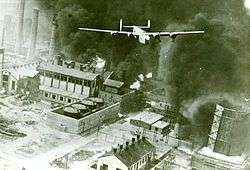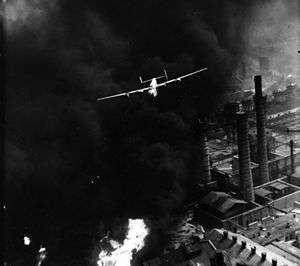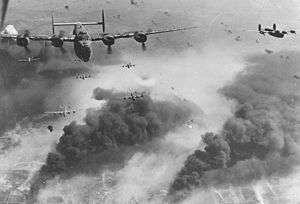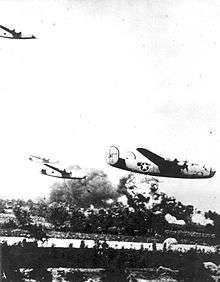Bombing of Bucharest in World War II
The Bucharest World War II bombings were primarily Allied bombings of railroad targets and those of the Oil Campaign of World War II, but included a bombing by Nazi Germany after the royal coup. Bucharest stored and distributed much of Ploiești's refined oil products.[1]
Raids
Chronology
| Date |
Target/Topic |
|
|---|
| 1944-04-04[2] |
Railroad targets |
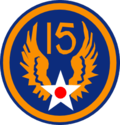 28 B-24s of the 449 BG[3] from Grottaglie, after taking the usual route past Turnu Severin, across the Southern Carpathians, and up to Târgoviște and Snagov, bombed for two hours at midday. The principal target was the Bucharest marshalling yard, Gara de Nord (tracks were destroyed). Warm weather and strong wind deflected bombs which landed on Calea Griviţei and Giulești and western/north-western Bucharest was severely hit, destroying hundreds of buildings and killing/injuring over 5,000. Bombs fell on Calea Victoriei, on the Splendid and Athenee Palace Hilton Bucharest Hotel Hotels; on the German Military Mission; near Cathedral of St. Joseph (destroying its stained-glass windows); and on Cotroceni, uprooting poplars in the Botanical Garden of Bucharest.[4] One bomb shelter was also destroyed.[4] Seven B-24s were lost from enemy aircraft (flak was slight and inaccurate over the target), and 13 B-24s were damaged and returned.[5] 717 BS losses included Reluctant Liz, Miasis Dragon, and from the 719th BS, Consolidated Mess, Dixie Belle, Paper Doll, Born to Lose, and B-24 #41-28655. Destroyed/probable/damaged Luftwaffe aircraft were 32/6/5 ME-109, 6/5/1 FW-190, 1/0/0 HE-113, 1/0/0 Me-210, and 0/2/0 JU-88. 28 B-24s of the 449 BG[3] from Grottaglie, after taking the usual route past Turnu Severin, across the Southern Carpathians, and up to Târgoviște and Snagov, bombed for two hours at midday. The principal target was the Bucharest marshalling yard, Gara de Nord (tracks were destroyed). Warm weather and strong wind deflected bombs which landed on Calea Griviţei and Giulești and western/north-western Bucharest was severely hit, destroying hundreds of buildings and killing/injuring over 5,000. Bombs fell on Calea Victoriei, on the Splendid and Athenee Palace Hilton Bucharest Hotel Hotels; on the German Military Mission; near Cathedral of St. Joseph (destroying its stained-glass windows); and on Cotroceni, uprooting poplars in the Botanical Garden of Bucharest.[4] One bomb shelter was also destroyed.[4] Seven B-24s were lost from enemy aircraft (flak was slight and inaccurate over the target), and 13 B-24s were damaged and returned.[5] 717 BS losses included Reluctant Liz, Miasis Dragon, and from the 719th BS, Consolidated Mess, Dixie Belle, Paper Doll, Born to Lose, and B-24 #41-28655. Destroyed/probable/damaged Luftwaffe aircraft were 32/6/5 ME-109, 6/5/1 FW-190, 1/0/0 HE-113, 1/0/0 Me-210, and 0/2/0 JU-88. |
| 1944-04-15[6] |
Railroad targets |
 15th US Air Force 461st Bombardment Group B-24s targeted Chitila Marshalling Yard in Bucharest. Nine-tenths cloud coverage over the target prevented the crews from observing the effect of the bombing. Official records do not list the damage.[7] Other sources report that the University of Bucharest was damaged and the adjacent Cartea Românească building was destroyed in bombing raid.[8]:190 15th US Air Force 461st Bombardment Group B-24s targeted Chitila Marshalling Yard in Bucharest. Nine-tenths cloud coverage over the target prevented the crews from observing the effect of the bombing. Official records do not list the damage.[7] Other sources report that the University of Bucharest was damaged and the adjacent Cartea Românească building was destroyed in bombing raid.[8]:190 |
| 1944-06-10 |
Romana Americana oil works, Ploesti |
 Raid by US P-38's. P-38's were used as it was felt that a low level dive-bombing attack could be more effective than the Tidal Wave high-level bombing where the targets were obscured by defensive smoke screens. The raid took place with three squadrons of 82d Fighter Group doing the attack (95th, 96th, 97th Squadrons) with three 1st Fighter Group squadrons (also P-38's) providing escorts (27th, 71st and 94th Squadrons). Mission was flown from Foggia airfields in Italy against Romana Americana oil works in Ploesti. Attack P-38's carried a 1000 lb bomb under one fuselage and a long-range tank under the other. Success was described as "an incremental contribution to previous bombing missions." 1 FG lost 14 P-38's and 82 FG nine aircraft, translating to 30% losses - equivalent to those of Tidal-Wave (but fewer manpower losses due to single crew aircraft being used as opposed to heavy bombers).[9] Raid by US P-38's. P-38's were used as it was felt that a low level dive-bombing attack could be more effective than the Tidal Wave high-level bombing where the targets were obscured by defensive smoke screens. The raid took place with three squadrons of 82d Fighter Group doing the attack (95th, 96th, 97th Squadrons) with three 1st Fighter Group squadrons (also P-38's) providing escorts (27th, 71st and 94th Squadrons). Mission was flown from Foggia airfields in Italy against Romana Americana oil works in Ploesti. Attack P-38's carried a 1000 lb bomb under one fuselage and a long-range tank under the other. Success was described as "an incremental contribution to previous bombing missions." 1 FG lost 14 P-38's and 82 FG nine aircraft, translating to 30% losses - equivalent to those of Tidal-Wave (but fewer manpower losses due to single crew aircraft being used as opposed to heavy bombers).[9] |
| 1944-06-28 |
Oil refineries |
 The 464 BG bombed the "Prohava [sic] Petrolul" refinery and the 485 BG bombed the "Titan Oil Refinery".[10] The 464 BG bombed the "Prohava [sic] Petrolul" refinery and the 485 BG bombed the "Titan Oil Refinery".[10] |
| 1944-08-17/18 |
Oil refineries |
 RAF 37 Sqn and other 205 Gp Sqn's. Raid was aimed at destroying remaining intact refineries. Original target for the raid was the Standard Oil Refinery, but this had been successfully attacked during the day by American Forces and at 16:00 the attack was changed to the Xenia refinery. Raid was conducted by 63 Wellingtons from 231, 236, and 330 Wings, 9 Liberators from 2 SAAF Wing and 6 Halifaxes from 614 Sqn. 22 aircraft returned to bases because of mechanical failures, 3 performed emergency landings en route and 3 were reported missing. Remaining aircraft reached the target but AA defences were very active as was the smoke screen resulting in no aircraft being able to pinpoint the target. Bombers were attacked by Ju 88 and Me 109's. 86 tons of bombs dropped but the raid was considered as unsuccessful.[11] RAF 37 Sqn and other 205 Gp Sqn's. Raid was aimed at destroying remaining intact refineries. Original target for the raid was the Standard Oil Refinery, but this had been successfully attacked during the day by American Forces and at 16:00 the attack was changed to the Xenia refinery. Raid was conducted by 63 Wellingtons from 231, 236, and 330 Wings, 9 Liberators from 2 SAAF Wing and 6 Halifaxes from 614 Sqn. 22 aircraft returned to bases because of mechanical failures, 3 performed emergency landings en route and 3 were reported missing. Remaining aircraft reached the target but AA defences were very active as was the smoke screen resulting in no aircraft being able to pinpoint the target. Bombers were attacked by Ju 88 and Me 109's. 86 tons of bombs dropped but the raid was considered as unsuccessful.[11] |
| 1944-07-31 |
Oil refineries |
 Two oil refineries at Bucharest, one at Doicești, and oil storage at Târgoviște were bombed. Two oil refineries at Bucharest, one at Doicești, and oil storage at Târgoviște were bombed. |
| 1944-08-06 |
Railroad targets |
 60 fighters from Operation FRANTIC bases in the USSR attacked the Craiova marshalling yard and other railroad targets in the Bucharest-Ploești, Romania area, and landed at Italian bases. 60 fighters from Operation FRANTIC bases in the USSR attacked the Craiova marshalling yard and other railroad targets in the Bucharest-Ploești, Romania area, and landed at Italian bases. |
| 1944-08-23/24 & 24/25 |
|
.svg.png) Luftwaffe bombers based in Otopeni attacked Bucharest on two consecutive nights until their bases were bombed by the Allies. The National Theatre Bucharest and several other downtown buildings were destroyed while the Royal Palace, the Victoria Palace, and the Romanian Athenaeum were seriously damaged.[8]:212 Luftwaffe bombers based in Otopeni attacked Bucharest on two consecutive nights until their bases were bombed by the Allies. The National Theatre Bucharest and several other downtown buildings were destroyed while the Royal Palace, the Victoria Palace, and the Romanian Athenaeum were seriously damaged.[8]:212 |
|
| Bombing of Bucharest and Ploești |
|---|
| One of the Operation Tidal Wave B-24s over a burning oil refinery at Ploesti, Romania, 1 August 1943. |
| The Sandman B-24, piloted by Robert Sternfels, as it emerges from a pall of smoke during the Tidal Wave mission. |
| "15th Air Force B-24s leave Ploesti, Romania, after one of the long series of attacks against the No. 1 oil target in Europe" (National Museum caption). |
| Oil storage tanks at the Columbia Aquila refinery burning after the raid of B-24 Liberator bombers of the United States Army Air Force. Some of the structures have been camouflaged. |
| Bomb damage visible in Columbia Aquila refinery in Ploesti, Romania. |
| B-24 Liberators at low altitude while approaching the oil refineries at Ploesti, Romania, August 1, 1943. |
|
References
- ↑ Stout, Jay A (November 2003). Fortress Ploesti: The Campaign to Destroy Hitler's Oil Supply. p. 190. Retrieved 2009-02-04.
- ↑ McKillop, Jack. "Combat Chronology of the USAAF". Retrieved 2007-05-25.
1944:
January,
February,
March,
April,
May,
June,
July,
August - ↑ review of "Ted's Travelling Circus: 93rd Bombardment Group (H) 1942-1945", by Scott A. Willey, Air Power History, Fall 1998
- 1 2 (Romanian) "Ia-ţi Bucureştii - Cotroceniul liniştit" ("Keep Bucharest - Cotroceni Is Quiet"), Jurnalul Naţional, August 31, 2006
- ↑ USAF Historical Research Agency
- ↑ "Campaign Diary". Royal Air Force Bomber Command 60th Anniversary. UK Crown. Retrieved 2009-05-10.
1944:
January,
February
March,
April,
May,
June,
July,
August - ↑ "461st Bombardment Group". Mission Records: April 1944.
- 1 2 Giurescu, Constantin C. (1966). Istoria Bucureştilor. Din cele mai vechi timpuri pînă în zilele noastre (English: History of Bucharest. From the earliest times to our day). p. 190,212.
- ↑ Stout, Jay, A.C. (2011). Fortress Ploesti: The Campaign to destroy Hitler's oil. Havertown, PA.: Casemate. pp. 151–166. ISBN 978-1-935149-39-2.
- ↑ Mission histories for Bombardment Groups:
- "464 BG": "Our Missions: The 464 BG Mission List".
- "485 BG": "tbd".
- ↑ Macisaac, James, J. "The WWII History of James Macisaac and RAF 37 Squadron". Op 6 · Ploesti, Xenia Oil Refinery. Retrieved 15 July 2011.

